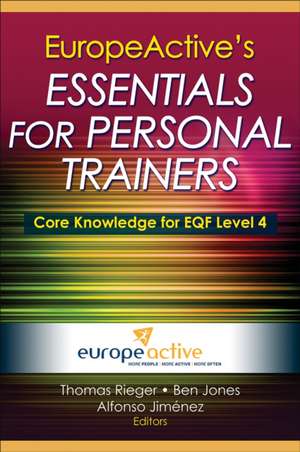EuropeActive`s Essentials for Personal Trainers
Autor Europeactive Europeactiveen Limba Engleză Hardback – feb 2016
Preț: 304.28 lei
Nou
58.28€ • 60.04$ • 48.82£
Carte indisponibilă temporar
Specificații
ISBN-10: 1450423787
Pagini: 320
Ilustrații: black & white illustrations, black & white halftones
Dimensiuni: 189 x 254 x 26 mm
Greutate: 0.82 kg
Editura: MG – Human Kinetics
Descriere
EuropeActive’s Essentials for Personal Trainers provides personal trainers with the most thorough information and best practices to help their clients achieve their health and fitness goals. Endorsed by EuropeActive, the fitness and health industry’s standard-setting authority in Europe, this manual is essential for all aspiring and qualified personal trainers and aims towards EuropeActive’s objective: “More people, more active, more often.”
The information contained in EuropeActive’s Essentials for Personal Trainers provides aspiring personal trainers with the basic competencies, skills and knowledge necessary for achieving level 4 status in the European Qualifications Framework (EQF), the baseline standards for registered personal trainers in Europe. The content builds on foundational concepts to provide practical knowledge and on-the-job examples to personal trainers so that they can deliver enjoyable and effective services to their clients.
Authored by fitness experts throughout Europe, EuropeActive’s Essentials for Personal Trainers provides a standard reference to inform this growing field. The first three chapters describe the role of the personal trainer, with topics covering professionalism and presentation, planning a personal training session and delivering a personal training session. Readers will then learn functional anatomy with chapters on skeletal articulations and joint movement, injury prevention and the muscular system. To understand the science behind exercise prescription, readers will learn about energy systems, the cardiorespiratory system, the nervous system and hormonal responses to exercise. Chapters focusing on lifestyle assessment, including health and fitness assessment, psychological aspects of personal training and nutrition, allow personal trainers to understand the unique needs of the various clients they serve. The book concludes with chapters on training adaptations as well as exercise planning and programming.
With more and more people turning to professionals for assistance in their quest for better health and fitness, the demand for qualified personal trainers in Europe has never been greater. EuropeActive’s Essentials for Personal Trainers is an ideal resource for those aspiring to become personal trainers in Europe and equips current professionals in the fitness industry with the tools they need in effectively serving their clients. Personal trainers who achieve EQF level 4 status demonstrate to both clients and employers that they have all of the pertinent knowledge and skills to be successful anywhere in Europe.
Cuprins
Preface
Chapter 1. Professionalism and Presentation
Jan Middelkamp
Personal Training
Examining the Sector of Personal Training
Professionalism of Personal Trainers in Business
Presentation and Qualifications in Personal Training
Marketing and Sales
Conclusion
Chapter 2. Planning a Personal Training Session
Davide Filingeri and Thomas Rieger
Principles and Characteristics of Personal Training
Planning Activities
Conclusion
Chapter 3. Delivering a Personal Training Session
Nuno Pimenta
Monitoring and Adjusting Exercise
Maintaining Good Communication and Motivation
Different Personal Training Environments
Extending Frequent and Good Communication to Clients
Conclusion
Chapter 4. Skeletal Articulations and Joint Movement
Daniel Robbins and Mark Goss-Sampson
Connective Tissue
Joint Structure
Lever Systems
Effects of Resistance Training on Joints
Conclusion
Chapter 5. Injury Prevention
Pauline Jacobs and John van Heel
Osteoporosis
Spinal Injury Prevention
Shoulder Stabilisation
Ligamentous Damage
Conclusion
Chapter 6. Muscular System
Anders Nedergaard
Contraction Types and Their Characteristics
Acute Muscle Adaptations to Different Training Types
Chronic Muscle Adaptation to Training
Muscle Functions of the Hip and Thoracolumbar Fascia
Conclusion
Chapter 7. Energy Systems
Francesco Bertiato and Simonetta Senni
Three Energy Systems
Acute Variables and Energy Systems
Effects of EPOC and Interval Training on Metabolism
Fat Burning
METs and Calories
Methods for Monitoring Exercise
Use of Energy from Nutrients
Conclusion
Chapter 8. Cardiorespiratory System
Christoffer Andersen
Cardiovascular System
Respiratory System
Conclusion
Chapter 9. Nervous System
Alexis Batrakoulis
Organisation of the Nervous System
Function of the Nervous System
Nervous System and Exercise
Conclusion
Chapter 10. Hormonal Responses to Exercise
Sabrena Merrill and Cedric X. Bryant
Structural Overview of the Endocrine System
Classification of Hormones
Hormone Interactions with Target Cells
Hormonal Responses to Acute Exercise
Hormonal Adaptations to Chronic Exercise Training
Conclusion
Chapter 11. Health and Fitness Assessment
Nuno Pimenta, Samantha Jones and Ben Jones
Defining Health and Fitness
Preliminary Health Assessment
Fitness Assessments
Conclusion
Chapter 12. Psychological Aspects of Personal Training
Chris Beedie
Role of Psychology in Personal Training
Goals and Goal Setting
Beliefs and Expectations
Emotions, Stress and Coping
Conclusion
Chapter 13. Nutrition
Fernando Naclerio and Robert Cooper
Energy Requirement
Estimating Energy Expenditure
Calculating Energy Needs
Recommended Dietary Intakes
Healthy Eating Patterns
How Dietary Intake Influences Health
Micronutrient Deficiency and Health
Fads and Popular Diets
Food Pyramid and MyPlate Dietary Plan
Developing a Healthy, Balanced Way of Eating
Tobacco, Alcohol and Caffeine
Fat and Lipoprotein
Safe and Effective Weight Loss and Gain
Conclusion
Chapter 14. Training Adaptations
Rafael Oliveira, João Brito and Ben Jones
Adaptations to Training Principles
Adaptations to Resistance Training
Adaptations to Aerobic Training
Adaptations to Range of Motion Training
Conclusion
Chapter 15. Exercise Planning and Programming
Christoffer Andersen, Thomas Rieger and Lars L. Andersen
Planning for Resistance Training
Planning for Aerobic Endurance Training
Applied Training Programming
Examples of Exercise Programming
Conclusion
Appendix. European Qualifications Framework (EQF) Level 4 Personal Trainer
References
About the Editors
About EuropeActive
Contributors
